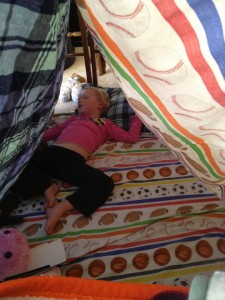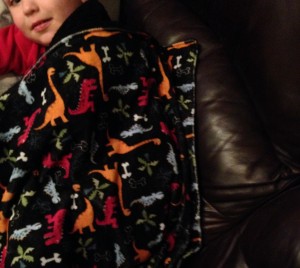This next post in the series of how kids don’t need toys to play, because they play with anything, uncovers play with blankets. No cover up here. (Pun gleefully intended.)
 One of the first and most universal ways to play with blankets is the game of peek-a-boo. Babies and older kids love to hide in plain sight. At first, this now-you-see-me, now-you-don’t is a way to discover people and objects don’t disappear just because we can’t see them. Later, the game becomes a way to confirm a connection to others. Kids feel reassured to know we will look for them and will find them.
One of the first and most universal ways to play with blankets is the game of peek-a-boo. Babies and older kids love to hide in plain sight. At first, this now-you-see-me, now-you-don’t is a way to discover people and objects don’t disappear just because we can’t see them. Later, the game becomes a way to confirm a connection to others. Kids feel reassured to know we will look for them and will find them.
A favorite way to play with blankets is to build a blanket fort. A really big blanket can be draped over a table for a very quick and easy fort. Kids can make a much more elaborate one using the sofa, several chairs, or a clothesline. Not just inside the house, but outside too, kids may be able to rig up one with blankets, trees, and poles.
 A blanket can be an outward expression of caring. Kids wrap up dolls and stuffies with blankets. One young girl followed grandpa’s example of tender loving care for his tractor and so wrapped up her toy one and cradled it in her arms.
A blanket can be an outward expression of caring. Kids wrap up dolls and stuffies with blankets. One young girl followed grandpa’s example of tender loving care for his tractor and so wrapped up her toy one and cradled it in her arms.
The fairy tale of the princess and the pea, who had to prove herself is also a story of how it feels when other people doubt our word. We emerge from the experience covered in emotional bruises like the princess when others can’t see us for who we really are. No matter how high the pile of blankets, there is deep pain. Children with high sensory-needs often like a heavy pile of blankets. The weighted sensation helps them deal with sensory information, either stimulating or calming them. A blanket can also provide a feeling of security. A child’s play with blankets is meeting both physical and emotional needs.
Play with blankets isn’t undercover, even tho kids might be. It’s just so obvious we can’t see it. Do you remember hiding under the blankets with a flashlight so you could read or tell ghost stories? Does your child have a favorite blanket? Do you?

